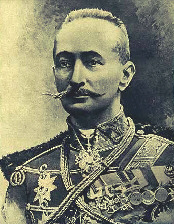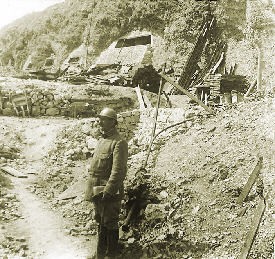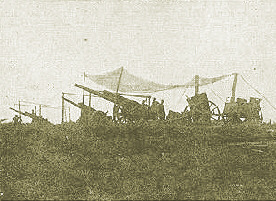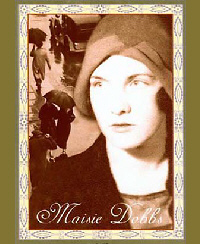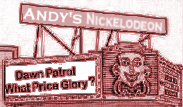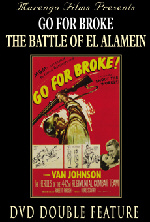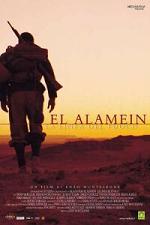
June 2006 |
Access Archives |
TRENCH REPORT: Back from the Western Front. Beginning with this issue, the Trip-Wire will feature a number of images and reports on my first visit to the battlefields in three years. However, I must give tidings of two important cultural trends which became evident during our first few days in Paris. One is slightly gratifying, the other I find slightly ominous. First, the baseball cap has totally routed the beret. While the American ball caps are so prevelant they quickly become unnoticed, we did not spot a single beret during two weeks in France. No wonder our culture is felt to be so threatening by Europeans. Second--I missed the significance of this on its earlier pass through the States--but it's clear the next "BIG THING" heading back to our shores is Cow Art. Imagine your community invaded by hundreds of inscrutable, life-size ceramic cows with decorative schemes reflecting the entire post-Warhol history of art. It has a distinct "Easter Island" feeling to it. Here is specimen of what's coming our way. MH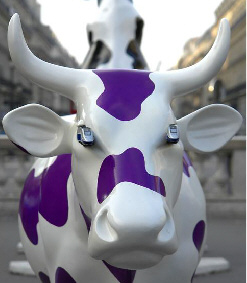 WWI's Influence on Today's Air Tactics and Doctrine
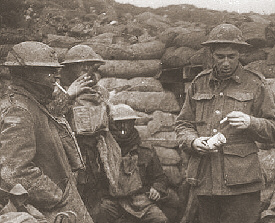 Almost a Different World |
|||||||||||||||||
|
New at the Websites of the Great War Society and Our Friends
|
At Great War Society Sites
|

| Among the US Army officers who worked on the relief effort following the 1906 San Francisco Earthquake and Fire was Signal Corps Captain William Mitchell. (photo) |
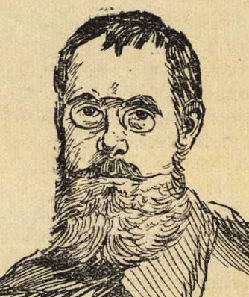
Charles Péguy: Socialist, Dreyfusard, Catholic Apologist, Epigrammist, Opponent of Jaurès, KIA at Opening of the Battle of the Marne, Villeroy, Sept 5, 1914.
GREAT WAR 2006 EVENT CALENDAR | |
|
90th Commemorative Events Comprehensive Double Calendar Scheduled Throughout 2006 (link) | |
|
Hilton Garden Inn, Tampa North August 16 (link) | |
|
Hartford, Connecticut November 11th (Program) | |
|
An International View of the Great War With our Friends Jean- Pierre & Cecile Mouraux Sonoma, California Check back for Details November 11th | |
|
Email Response |
|
To mark the 90th anniversary of the Battle of the Somme London's Imperial War Museum is launching an on-line exhibition exploring the longest and most costly land battle in British history. A number of key items from the Museum's extensive First World War collection will be digitized and readily available to the wider public for the first time in this unique on-line display covering the Battle itself, the stories of the people involved and the battlefields today. (link). . .Thanks for all the positive feedback from those of you who saw my recent appearance on the History Channel program World War I Declassified. I agree with you who felt the main script was not too strong, but that we "talking heads" including Bob Doughty, Tom Fleming and Len Shurtleff held our own. . .Read a review by James Bowman on the French Christmas Truce film Joyeux Noel. (link)
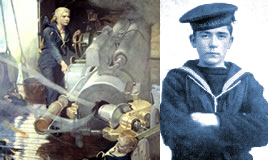
John T. Cornwell, HMS Chester
Boy 1stCl,Youngest VC Recipient
Died at Jutland, 2 June 1916
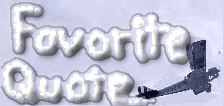
The 1918 influenza viruses evolved their unique combination of high virulence and high transmissibility in the conditions at the Western Front of World War I. By transporting contagious flu patients into a series of tightly packed groups of susceptible individuals, personnel fostered transmission from people who were completely immobilized by their illness.
Such conditions must have favored the predator-like variants of the influenza virus; these variants would have a competitive edge because they could ruthlessly exploit a person for their own replication and still get transmitted to large numbers of susceptible individuals. These conditions have not recurred in human populations since then and, accordingly, we have never had any outbreaks of influenza viruses that have been anywhere near as harmful as those that emerged at the Western Front.
Paul W. Ewald, Evolutionary Biologist
University of Louisville;
Author, Plague Time
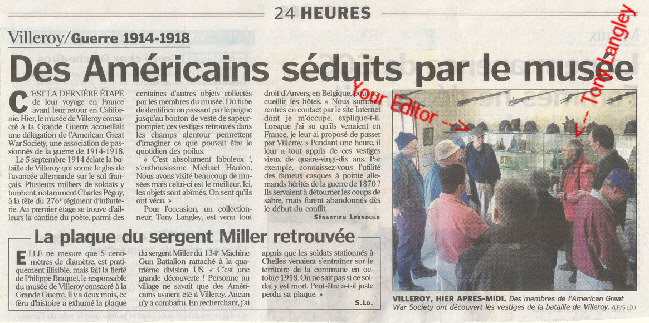
The Recent Battlefield Tour Led by Editor Mike Hanlon Was Covered by Paris Newspaper, Le Parisien;
Contributor Tony Langley Also Rendezvoused With Us at the Marne Museum in Villeroy
Contact Mike if you would like information on next year's tour (email)
 |
Post Your World War I Stumper Here |
Long-time Great War Society member Peter Wood's mother Lilian served as a Volunteer Aid Detachment Nurse in the war. Proud of her service, Peter has been seeking to acquire one of the VAD medallions like Lilian is wearing in the photo on the right. The usual places to find such items, like EBay, have not proven helpful. |
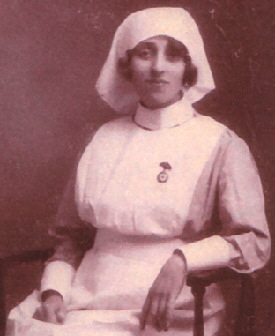 Nurse Lilian Gardner (Wood) |
|
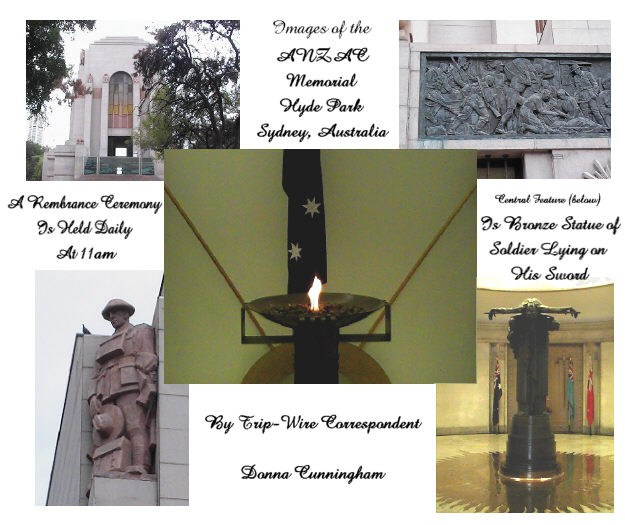
|
Verdun |
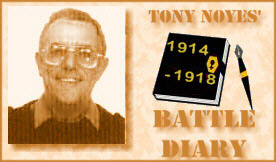 |
The Somme | |
On the first of June the Germans struck at Fort Vaux and a siege of medieval proportions took place, with the attacking forces on the roof and round the ditches, and the French defenders inside.
After seven days the garrison surrendered with military honours and the way was now clear to advance along the ridge towards Verdun which was overlooked by the next Fort, Souville.Click Here to See a Large
|
They became hardened to hardship. Life in the trenches was long periods of boredom interspersed with moments of screaming fear. Life was dominated by "Stand To" at dawn and dusk when every man fixed bayonets and stood waiting for the never coming German attack. Life was dominated by the issue of the rum ration, by sentry duty, by the need for sleep and by never, never ending work. It was dominated by the need to be alert for snipers, for incoming mortars called miniewerfers, for incoming artillery, and by the thought of ?when can we be relieved into support positions, into reserve, anywhere out of this lousy place?. It was dominated by bad food, bad teeth, bad sanitary arrangements, lice, and fear. Click Here to See a Large
|
|
|
in the 21st Century |
- Here's your grenade -- you want fries with that?
- Woman in B.C. rest home could be Britain's last living female veteran of the Great War
- President Asked to Intervene in Soledad Cross Conflict [WWI Memorial]
- Montana Pardons WWI Seditionists
|
|

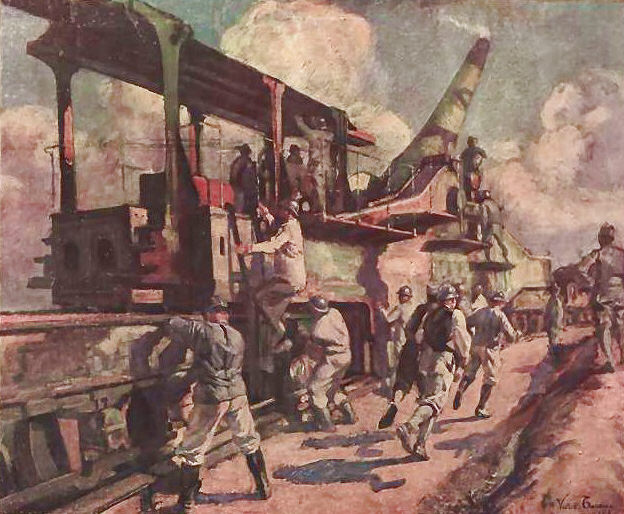
Railroad Mounted Artillery [Possibly at Verdun]
By Distinguished French War Artist Victor Tardieu
The second battle of El Alamein was fought between October 23, 1942 and November 4, 1942. General Bernard Montgomery commanded the British Eighth Army and was opposed by Field Marshall Irwin Marshall. Both Montgomery and Rommel were veterans of the First World War. Montgomery had served on the Western Front and was severely wounded in 1914. He then served as a staff officer for the remainder of the war. His Great War experience brought about a determination during the Second World War to win battles at a minimum cost in human life. In this, he was not alone, no wartime commander who had witnessed the horror of the prolonged ineffectual battles of the First World War wished to repeat the experience. Rommel joined the German Army in July 1910. By the end of the First World War he was a captain and had been awarded the Pour le Mérite. In 1937, Rommel published Infanterie Greift An: Erlebniss und Erfahrungen (Infantry Attacks, English edition). In his book he drew upon his experiences to provide lessons for infantry commanders. A brilliant tactician, Rommel was well suited to desert warfare. The war in North Africa has been the topic of numerous movies: Desert Victory, The Desert Fox, The Desert Rat, Rats of Tobruk, etc. Two movies from Italy are currently available on DVD, The Battle of El Alamein (La Battaglia di El Alamein, 1969) and El Alamein: The Line Of Fire (El Alamein: La Linea Del Fuoco, 2002).
Andrew Melomet, Proprietor of Andy's Nickelodeon will answer your Great War film or video inquiry. He is also soliciting your recommendations for the WWI Filmography he is compiling for our readers. Just click HERE. |
| The following are thanked for their contributions to this issue of the Trip Wire:Gary Van Loon Sidney Clark, Christina Holstein, Bob Denison, Bob Ford, Tony Noyes, Esther MacCallum-Stewart, Andy Melomet, Len Shurtleff. Until next month, your editor, Mike Hanlon. |
Membership Information  Click on Icon |
SUBSCRIBE TO THE TRIP-WIRE (Or Send it to a friend.) (Or send us a comment on the TRIP-WIRE) CLICK HERE TO CONTACT US VIA EMAIL |
For further information on the events of 1914-1918
visit the Directory Page of |

